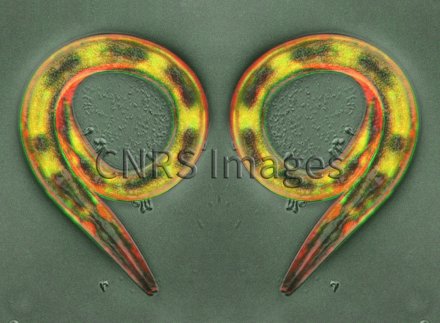Production year
2014

© Nathalie PUJOL / CIML / INSERM / CNRS Images
20170103_0008
Adult nematode worms, caenorhabditis elegans, infected with drechmeria coniospora fungus, observed using fluorescence and a differential interference contrast (DIC) microscope. The worms trigger the expression of antimicrobial peptides (shown by green fluorescent protein (GFP) in their epidermis (shown by red fluorescent protein (RFP). Upon detecting an infection or injury, the organism coordinates antimicrobial defence mechanisms with the healing process. Researchers have identified a ligand-receptor pair that is activated by injury and infection in nematode worms. They postulate an unprecedented role as a sentinel for derivatives of the amino acid tyrosine, and reveal the role of G-protein coupled receptors (GPCRs) in defending the host.
The use of media visible on the CNRS Images Platform can be granted on request. Any reproduction or representation is forbidden without prior authorization from CNRS Images (except for resources under Creative Commons license).
No modification of an image may be made without the prior consent of CNRS Images.
No use of an image for advertising purposes or distribution to a third party may be made without the prior agreement of CNRS Images.
For more information, please consult our general conditions
2014
Our work is guided by the way scientists question the world around them and we translate their research into images to help people to understand the world better and to awaken their curiosity and wonderment.